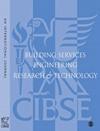Narrative modelling: A comparison of high and low mass dwelling solutions in Afghanistan and Peru
IF 1.8
4区 工程技术
Q3 CONSTRUCTION & BUILDING TECHNOLOGY
Building Services Engineering Research & Technology
Pub Date : 2022-09-10
DOI:10.1177/01436244221125720
引用次数: 2
Abstract
Displaced populations are housed in various constructions, including lightweight predesigned structures. Theoretically, self-built heavyweight structures should ensure better temperatures and be closer to cultural norms. To examine this directly for the first time, lightweight pre-designed solutions are compared with high-mass self-built alternatives in Afghanistan and Peru, via monitoring, dynamic simulation, occupant surveys, the Shelter Assessment Matrix (SAM) and ShelTherm. Lightweight solutions increase peak summer temperatures, but only by 2°C, but reduce minimum temperatures by up to 5°C. Simulations only provided a qualitatively similar time series to the monitoring, because identical homes showed a large variance in temperatures. This questions the benefit of simulation compared to approaches which concentrate on whether shelters exacerbate or ameliorate external temperatures. In addition, a dwelling provides more than comfort, it supports family life, which is best addressed by tools like SAM, not thermal simulation. Hence it might be ideal to recommend high-mass self-build if possible, and to focus modelling efforts on qualitative aspects of simulation time-series, such as whether the building suppresses or exacerbates external conditions, and equally on psycho-cultural aspects. The term narrative modelling is introduced to describe this new approach which will be of direct benefit to the humanitarian community. Practical application Building simulation engineers have much to offer the humanitarian shelter sector, however they are not often brought into play in a disaster. Hence, we suggest a practical role they can take is in examining strategies before disasters and in creating knowledge or analysis methods that aid agency staff can apply on the ground. Here we showcase this approach. It is clear that although dynamic thermal simulation is highly useful, psycho-social aspects are equally important, thus engineers are likely to need to use tools that consider such aspects in order to maximize the usefulness of their conclusions.叙事模型:阿富汗和秘鲁高层和低层大众住宅解决方案的比较
流离失所的人口被安置在各种建筑中,包括轻量级的预先设计的结构。从理论上讲,自建的重量级建筑应该能保证更好的温度,更接近文化规范。为了第一次直接检验这一点,通过监测、动态模拟、居住者调查、住房评估矩阵(SAM)和ShelTherm,将轻量级预先设计的解决方案与阿富汗和秘鲁的大批量自建替代方案进行比较。轻质解决方案可使夏季峰值温度升高2°C,但可使最低温度降低5°C。模拟只提供了与监测质量相似的时间序列,因为相同的房屋显示出很大的温度差异。这就对模拟的好处提出了质疑,而模拟的好处主要集中在庇护所是否会加剧或改善外部温度。此外,住宅提供的不仅仅是舒适,它支持家庭生活,这最好通过像SAM这样的工具来解决,而不是热模拟。因此,如果可能的话,推荐大规模的自建可能是理想的,并将建模工作集中在模拟时间序列的定性方面,例如建筑是否抑制或加剧了外部条件,以及心理文化方面。引入“叙事模型”一词来描述这种将对人道主义界直接有益的新方法。建筑模拟工程师可以为人道主义避难所部门提供很多帮助,但是他们并不经常在灾难中发挥作用。因此,我们建议他们可以发挥的实际作用是在灾难发生前审查战略,并创造援助机构工作人员可以在实地应用的知识或分析方法。下面我们将展示这种方法。很明显,尽管动态热模拟非常有用,但心理-社会方面同样重要,因此工程师可能需要使用考虑这些方面的工具,以便最大限度地利用他们的结论。
本文章由计算机程序翻译,如有差异,请以英文原文为准。
求助全文
约1分钟内获得全文
求助全文
来源期刊

Building Services Engineering Research & Technology
工程技术-结构与建筑技术
CiteScore
4.30
自引率
5.90%
发文量
38
审稿时长
>12 weeks
期刊介绍:
Building Services Engineering Research & Technology is one of the foremost, international peer reviewed journals that publishes the highest quality original research relevant to today’s Built Environment. Published in conjunction with CIBSE, this impressive journal reports on the latest research providing you with an invaluable guide to recent developments in the field.
 求助内容:
求助内容: 应助结果提醒方式:
应助结果提醒方式:


